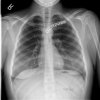Sternoclavicular Joint Instability: Symptoms, Diagnosis And Management
- PMID: 32801951
- PMCID: PMC7395708
- DOI: 10.2147/ORR.S170964
Sternoclavicular Joint Instability: Symptoms, Diagnosis And Management
Abstract
Sternoclavicular joint (SCJ) instability is a rare condition and results from either a traumatic high energy impact, such as a motor vehicle crash or contact sports injury, or non-traumatically as a result of structural pathology. The infrequency of this injury has contributed to its diagnosis being missed as well as the paucity of literature on treatment and outcomes. Patients with SCJ instability often report diminished range of motion as well as shoulder girdle pain. The presentation of instability in the sternoclavicular joint can vary in severity and anterior or posterior directionality. Variation in severity of the instability changes the course of treatment regarding either operative or non-operative interventions to stabilize the SCJ. In general, anterior instability of the SCJ (the medial clavicle is displaced anterior to the sternum) is less urgent and generally manageable by symptom alleviation and rehabilitation, although some anterior instability cases require surgical intervention. In the case of posterior SCJ instability (the medial clavicle is displaced posterior to the sternum), patients require prompt joint reduction as they are at the greater risk of life-threatening injury due to the location of critical structures of the mediastinum posterior to the SCJ. Computed tomography visualization is useful to confirm dislocation or subluxation direction to better formulate a proper treatment plan. The purpose of this review is to report the clinical presentation and management of SCJ instability including pertinent symptoms, the diagnostic approaches to evaluating SCJ instability, as well as operative and non-operative management of the joint instability.
Keywords: SCJ dislocation; sternoclavicular joint instability; surgical techniques.
© 2020 Garcia et al.
Conflict of interest statement
Dr. Brent Ponce reports personal fees from Wright Medical Inc, personal fees from ODi, personal fees from Mitek, personal fees from Stryker, outside the submitted work. Each author certifies that he or she has no commercial associations (eg, consultancies, stock ownership, equity interest, patent/licensing arrangements, etc.) that might pose a conflict of interest in connections with the submitted article. Additionally, there was no grant support or other funding methods associated with this article.
Figures





References
-
- Iannotti JP, Williams GR. Disorders of the Shoulder: Diagnosis & Management. 1 Lippincott Williams & Wilkins; 2007.
Publication types
LinkOut - more resources
Full Text Sources

